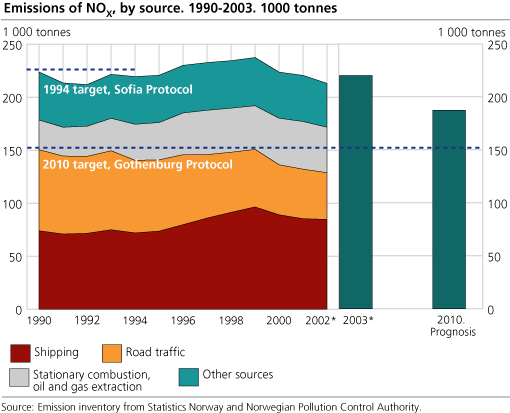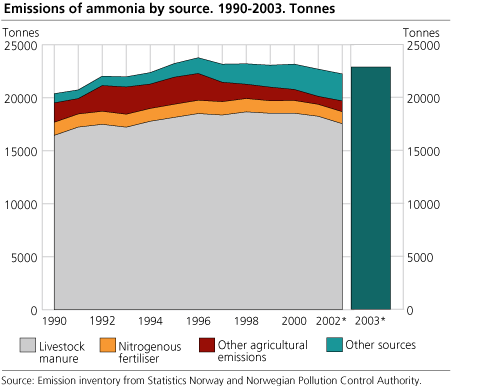Content
Published:
This is an archived release.
Strong growth in NOX emissions in 2003
Emissions of nitrogen oxides (NOX) increased by 3 per cent in 2003. Particularly emissions from sea transport, oil and gas extraction and heating were increasing. The growth took place in spite of Norway's obligation to reduce emissions considerably; according to the Gothenburg protocol emissions in 2010 should be reduced by 29 per cent from the present level.
This appears from preliminary calculations for 2003 from Statistics Norway and the Norwegian Pollution Control Authority.
In 2003, 220 000 tonnes NOX were emitted in Norway. This is almost 7 000 tonnes or 3 per cent more than in 2002. The growth increases the challenge to fulfil Norway's obligation in the Gothenburg protocol; according to this, the emissions in 2010 should not be higher than 156 000 tonnes, which is 29 per cent less than the present level.
Increase from gas production, heating and domestic shipping
The increased emissions are mainly caused by more use of oil products and higher emissions from oil and gas extraction. The main part of the latter comes from gas turbines used to produce electricity.
The article on emissions of greenhouse gases describes how high electricity prices caused more use of heating oils, which resulted in higher emissions. Increased use of marine fuels resulted in a corresponding increase in emissions.
Lower emissions from road traffic and process industry
The increase in NOX emissions is somewhat moderated by reduced emissions from road traffic because of a reduction in the number of cars without catalytic converters. Process emissions from the manufacturing industries were also reduced, particularly because of less production of iron, steel and ferroalloys.
|
Emission ceiling 2010 according to the Gothenburg
Protocol. Status 2003. Tonnes |
| Component | Emissions 1990 | Emissions 2003 | Emission ceiling 2010 | ||||||||||||||||||||||||||||||||||||
|---|---|---|---|---|---|---|---|---|---|---|---|---|---|---|---|---|---|---|---|---|---|---|---|---|---|---|---|---|---|---|---|---|---|---|---|---|---|---|---|
| Nitrogen Oxides (NOX) | 223 725 | 219 588 | 156 000 | ||||||||||||||||||||||||||||||||||||
| NMVOC | 294 395 | 301 431 | 195 000 | ||||||||||||||||||||||||||||||||||||
| Ammonia (NH3) | 20 375 | 22 853 | 23 000 | ||||||||||||||||||||||||||||||||||||
The source distribution of emissions in 2003 is uncertain, thus necessitating a reference to 2002 figures. That year, 40 per cent of Norwegian NOX emissions came from domestic shipping and fishing. Road traffic and oil and gas extraction contributed with 21 and 20 per cent, respectively, while 10 per cent were due to processes and combustion in the manufacturing industries. As international sea and air transport not are included in international environmental agreements, figures for these emissions are excluded from the statistics.
NMVOC reduced by 13 per cent
In 2003, 301 000 tonnes NMVOC (non-methane volatile organic compounds) were emitted in Norway, which is 43 000 tonnes less than in the preceding year. More than half of the emissions came from loading and storing of oil on the continental shelf. These emissions were reduced by no less than 21 per cent compared to 2002, due to more recirculation of oil vapour.
According to the Gothenburg protocol, the emissions should not exceed 195 000 tonnes in 2010. This means that it is necessary to reduce the emissions 35 per cent further to meet the obligation. It is expected that through the fulfillment of different demands for i.a. loading and storing of oil, the emissions in 2010 can be reduced to 160 000 tonnes.
Minor changes in ammonia emissions
In 2003, 22 900 tonnes of ammonia were emitted. This is at the same level as the year before and just below the obligation in the Gothenburg protocol (23 000 tonnes in 2010).
The source distribution for 2003 is still too uncertain to be published, but in 2002 89 per cent of the emissions came from agriculture, 9 per cent from petrol cars and 2 per cent from processes in the manufacturing industries.
Emission ceilings in the Gothenburg protocol
According to the Gothenburg protocol, Norway is obligated to keep the emissions of SO2, NOX, ammonia and NMVOC within certain emission ceilings in 2010. These ceilings are based on what nature can endure with regard to acid rain and ground-level ozone. Accordingly it is not intended that the obligations shall be fulfilled through international trading systems or other mechanisms as in connection with the Kyoto protocol.
Preliminary SO2 figures for 2003 will be published in June.
New figures on greenhouse gas emissions
Simultaneously with the emissions figures treated here, new data on greenhouse gas emissions are presented. Read the article .
In February, new figures on Norwegian emissions of persistent organic pollutants and heavy metals were presented. Read the article . At the same time, figures on the development of emissions of i.a. nitrogen oxides and NMVOC 1990-2002 were published (read the article ). Read more (in Norwegian) about the international environmental agreements Norway has signed.
Tables in the StatBank .
Tables:
The statistics is published with Emissions to air.
Contact
-
Statistics Norway's Information Centre
E-mail: informasjon@ssb.no
tel.: (+47) 21 09 46 42



